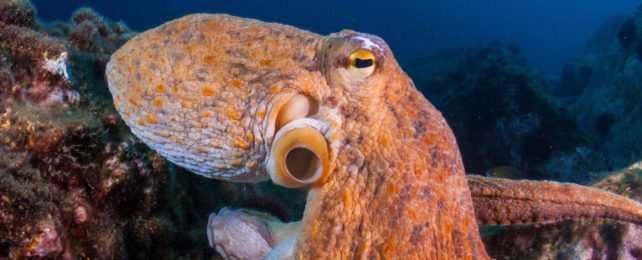A valiant effort to map the optic lobe of the octopus brain, cell by cell, has revealed a visual system with remarkable similarities and differences to our own.
The parallels are particularly interesting because they speak to the seemingly coincidental nature of convergent evolution.
Humans and octopuses diverged from a common ancestor 500 million years ago, and yet the ways our respective visual systems evolved to solve the same problems is uncanny. In spite of our different morphologies, lifestyles, and habitats, vertebrates and octopuses independently evolved a pupil and a lens that guides light onto a retina, for example.
Soft-bodied cephalopods – squids, octopuses, and cuttlefish – have the largest brains of any invertebrate, with two-thirds of their central processing tissue reserved just for sight.
As you'd expect from all that room, these ocean creatures have really good vision, even in the dark. The skin of an octopus contains the same pigment proteins as its eyes, allowing its dermis to 'see' the details of its surroundings and camouflage accordingly.
The current research by researchers at the University of Oregon is the first to comprehensively map the octopus visual system. It required an analysis of over 26,000 cells, collected during the dissection of two juvenile California two-spots (Octopus bimaculoides) octopuses.
Although the brains of these young octopuses were fully functioning, they appeared to be in the process of growing. In fact, nearly a third of the neurons distributed throughout the visual lobes looked as though they were still developing.
When researchers sequenced the cephalopod cells they found four main populations, each releasing a different chemical signal – some released dopamine, some released acetylcholine, some released glutamate, and others signaled with both dopamine and glutamate.
These neurotransmitters are also seen in vertebrate brains, like our own, but there were several smaller neuron clusters in the cephalopod brain that expressed unique chemicals.
A ring of cells around the optic lobe, for instance, was found to produce octopamine, a neurotransmitter closely related to a hormone in our bodies called noradrenaline.
Exactly what octopamine does in octopuses is a mystery that will require more research to solve. However, it is known to be active in the brains of fruit flies when they fly, and is important in many other invertebrates for functions relating to getting their bodies and nervous systems ready for action.
This new octopus brain map could help future efforts. Researchers identified several genetic transcription factors and signaling molecules that are unique to octopuses, which probably help shape neural development in some way.
Further studies could delete or muffle these factors to figure out their possible role in the cephalopod brain.
"The atlas we present here provides a roadmap for such studies, and more generally provides a path forward towards cracking the functional, developmental, and evolutionary logic of the cephalopod visual system," the authors write.
Similar to vertebrates, the octopus visual system is structured in layers, but not in the same way as our own. The diversity of cell types and the way in which they are organized in the cephalopod brain is fundamentally different.
"At the obvious level, the neurons don't map onto each other – they're using different neurotransmitters," explains biologist Cris Niell from the University of Oregon.
"But maybe they're doing the same kinds of computations, just in a different way."
One of the biggest questions is how the cephalopod visual system develops. Octopuses spend years growing massive brains, but how does information from the retina help direct that growth?
In vertebrates, photoreceptors in the retina don't connect directly to the brain. Instead, they hand off messages to other neurons. But in cephalopods, photoreceptors connect right on to the brain's optic lobes.
Future work is needed to explore how these direct messages influence the development of immature neurons, and how so many immature neurons finally integrate into a mature visual system.
Niell and his colleagues are now continuing their work to map the remaining third of the octopus brain.
The study was published in Current Biology.
